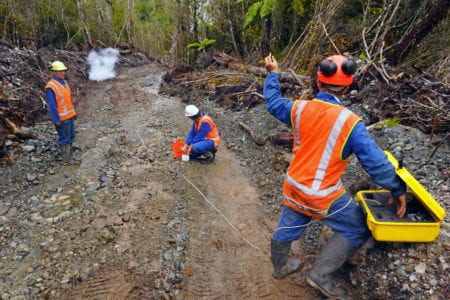The Strong Interest Inventory® Assessment categorizes Explosives Workers, Ordinance Handling Experts, and Blasters Career within The Investigative Theme Code. This Inventory serves two main functions: first, it categorizes careers into six Theme Codes based on the characteristics of people who generally pursue those careers, and second, it analyzes and evaluates individuals’ personal and workplace preferences in order to recommend careers which are a good fit for them. Investigative Careers generally center around gathering, examining, or analyzing data in the real world, and leveraging this information in different ways. People who prefer Strong Interest Inventory® Investigative Careers also tend to be strong in mathematics and the natural sciences and enjoy a reasonably flexible work environment.

Discover the Strong Interest Inventory® career as an Explosives Worker, Ordnance Handling Expert, and Blaster. Learn about this career in this data rich write-up including information such as income, daily tasks, required education and more.
Explosives Workers, Ordnance Handling Experts, and Blasters are all responsible for placing and detonating the explosives that are used to demolish buildings or remove materials for other engineering purposes, such as building roads or constructing new buildings. To do this, they first examine blast areas to develop a strategy for detonation, including determining what kinds of explosive charges would be best-suited, as well as their quantity. Second, they place safety cones to mark off the blast radius clearly, so that other workers can avoid the area. Third, they drill and place the explosive charges, which may include ammonium nitrate, black powder, or slurries, and tie specific lengths of fuses to the charges so that their explosions will be timed appropriately. Finally, they detonate the explosives. As they complete their tasks, explosives workers need to keep careful and accurate records of their explosives, and also need to ensure that they are complying with local and federal laws and ordinances. They make sure that the placement of their charges will only damage areas within the blast radius. They assure this by measuring the depth of drilled blast holes using weighted tape measures, and by drilling said holes using jackhammers and similar equipment.
Explosives Workers and Blasters use many different kinds of construction and explosive tools. Construction tools include core drills, calipers, cable reels, dollies, hoists, ladders, levels, pliers, balances, hammers, jackhammers, mallets, and ammeters, while explosive tools include ammonium nitrate, remote firing detonators, safety fuses, and tampers. In addition, they also need to be comfortable using many different kinds of construction machinery, like forklifts, place robots, and overhead cranes, as well as safety equipment, including goggles, grappling hooks, ear plugs, hard hats, protective gloves, respirators, and safety harnesses. Additionally, they must have the ability to quickly and confidently learn to use new machinery as it becomes necessary on the job.
Most Explosives Workers have achieved a High School Diploma (63%) alone, and some (21%) hold a post-secondary certification. Just under 10% of them attempted to attend some college, but never actually graduated and earned a degree. However, more important than a formal education is the ability to listen carefully to instructions and background information, critically evaluating multiple aspects of a situation in detail, and making timely judgments on how to resolve problems they may find. The job can be very physically demanding, and so Explosives Workers benefit from having strong manual and finger dexterity and hand-arm steadiness, as well as acute near vision, and the ability to coordinate multiple limbs in concert with one another. They need the ability to judge distances accurately and quickly when comparing similarities and differences between or among different objects. Lastly, they should be confident communicating in English.
An Explosives Workers and Blaster’s salary varies enormously around the country—the average Explosives worker in Washington, Wyoming, and Alaska earn up to $75,000, with the best paid Explosives’ workers earning as much as $115,000. On the other hand, the state mean in Texas and much of the south, is a lesser amount of $40,000. That said, the rate of employment of Explosives Workers is expected to rise Nation-Wide. Though it is projected to be slower than average (just 2% to 4%), western states like Arizona, Nevada, and Washington are projected to grow nearly 20% before 2024, while New York is not far behind at 17.5% predicted growth.
Below are some employment trends for Explosives Workers, Ordnance Handling Experts, and Blasters
- Median Salary: $22.24 hourly, $46,250 annually
- Employment: 5,900 employees
- Projected growth (2018-2028): Average (4% to 6%)
- Projected job openings (2018-2028): 800
Visit Our Strong Interest Inventory® Resource Page
Visit Our Myers-Briggs Type Indicator® Career Resource Database for Information on MBTI® Personality Type Careers
To Learn More About the Myers-Briggs Type Indicator, visit our About MBTI Test Page
Gain access to your best-fit careers, occupational preferences and interests with these career based Strong Interest Inventory® Assessments:
-
MBTI® Career Report + Strong & MBTI Combined Career Report + Strong Profile
Price: $96.95 Buy NowDIGITAL DELIVERY
- Three of the top career-focused tests included
- Designed to uncover the best career fit for your true self
- Links to complete assessments are sent digitally via email within 2-3 business hours of purchase
- Results sent in PDF form via email within 6-8 business hours
Download Sample MBTI® Career Report
Download Sample Strong & MBTI® Combined Career Report Plus Strong Profile
Download Sample Strong Interest Inventory® Profile Report
-
Strong Interest Inventory® Interpretive Report
Price: $64.95 Buy NowDIGITAL DELIVERY
- This report starts with the same foundation as the Strong Interest Inventory Profile but goes even further into analyzing your likes and dislikes and how that can help you lead a more fulfilling, satisfied life
- Dive deeper into what your interests, hobbies, favorite topics, and vocations could mean for your career and personal life
- Links to complete assessments are sent digitally via email within 2-3 business hours of purchase
- Results sent in PDF form via email within 6-8 business hours
Download sample Strong Interest Inventory® Interpretive Report
-
Strong Interest Inventory® Profile
Price: $54.95 Buy NowDIGITAL DELIVERY
- Set yourself up for success by choosing a career that reflects your personal interests, preferences, likes, and dislikes
- This test compares your preferences against professionals actively in specified industries, rather than basing results on theory alone
- Links to complete assessments are sent digitally via email within 2-3 business hours of purchase
- Results sent in PDF form via email within 6-8 business hours
-
Strong Interest Inventory® & Skills Confidence Profile + Strong Interpretive Report
Price: $72.95 Buy NowDIGITAL DELIVERY
- Better understand your strengths, interests, preferences, and areas of confidence
- Connect your innate traits to a successful and satisfying career
- Links to complete assessments are sent digitally via email within 2-3 business hours of purchase
- Results sent in PDF form via email within 6-8 business hours
Download sample Strong Interest Inventory® & Skills Confidence Profile + Strong Interpretive Report
-
iStartStrong™ Report
Price: $39.95 Buy NowDIGITAL DELIVERY
- Plan your future career based on your interests and passion
- Start on the right path to finding a career that you’ll enjoy for years to come
- Links to complete assessments are sent digitally via email within 2-3 business hours of purchase
- You will be able to self-download your report as a PDF document immediately following the completion of your assessment.
Explore our Strong Interest Inventory® Blog Pages:
- Strong Interest Inventory Realistic Theme Explained
- Strong Interest Inventory Artistic Theme Explained
- Strong Interest Inventory Investigative Theme Explained
- Strong Interest Inventory Social Theme Explained
- Strong Interest Inventory Enterprising Theme Explained
- Strong Interest Inventory Conventional Theme Explained
Assessment Categories
References
- Bureau of Labor Statistics wage data and 2012-2022 employment projections Onetonline.org














